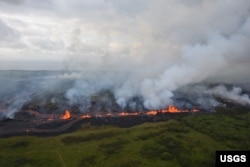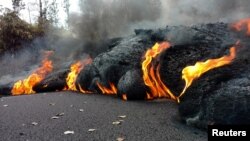A man was seriously injured when he was hit by lava spatter while standing on his third-floor balcony, in the first known significant injury related to Hawaii's Mount Kilauea eruptions that began on May 3.
The lava "hit him on the shin, and shattered everything from there down on his leg," Janet Snyder, spokeswoman for the Hawaii County mayor, told the Hawaii News Now TV station.
WATCH: Volcano injury
Lava that's erupting from cracks in the Earth can weigh as much as a refrigerator and even small pieces can be lethal, officials said.
They released no other information about the man or his condition.
Two lava streams have entered the ocean, sending hydrochloric acid and steam with fine glass particles into the air, which can lead to lung damage, and eye and skin irritation, the Hawaii County Civil Defense agency said.
One stream blocked a key Hawaii highway that serves as an escape route for coastal residents as two of 22 fissures had merged.
Magma destroyed four more homes, as the Hawaii National Guard warned of mandatory evacuations if more roads were blocked.
Since the first fissure opened, lava had been mostly spattering up and collecting at the edges of the cracks in the ground. However, fresher magma is now coming up and flowing faster and farther.
Kilauea is the most active volcano in the world and one of five on the Big Island. Since May, about 2,000 people have been forced to evacuate, and lava has destroyed more than 40 homes.
Scientists do not anticipate fatalities in the event of a large eruption because most of the exposed residential communities have already been evacuated, and the southeastern part of the island where the volcano is located is sparsely populated.
Most of the Big Island and the rest of the state's island chain have not been affected by the volcanic activity. Officials say flights to and from the Big Island and the rest of the state have not been impacted.
County officials, however, have been urging area residents to be ready for possible evacuation, as scientists believe the volcanic activity may precede a major eruption similar to one that rocked the island in the mid-1920s.














